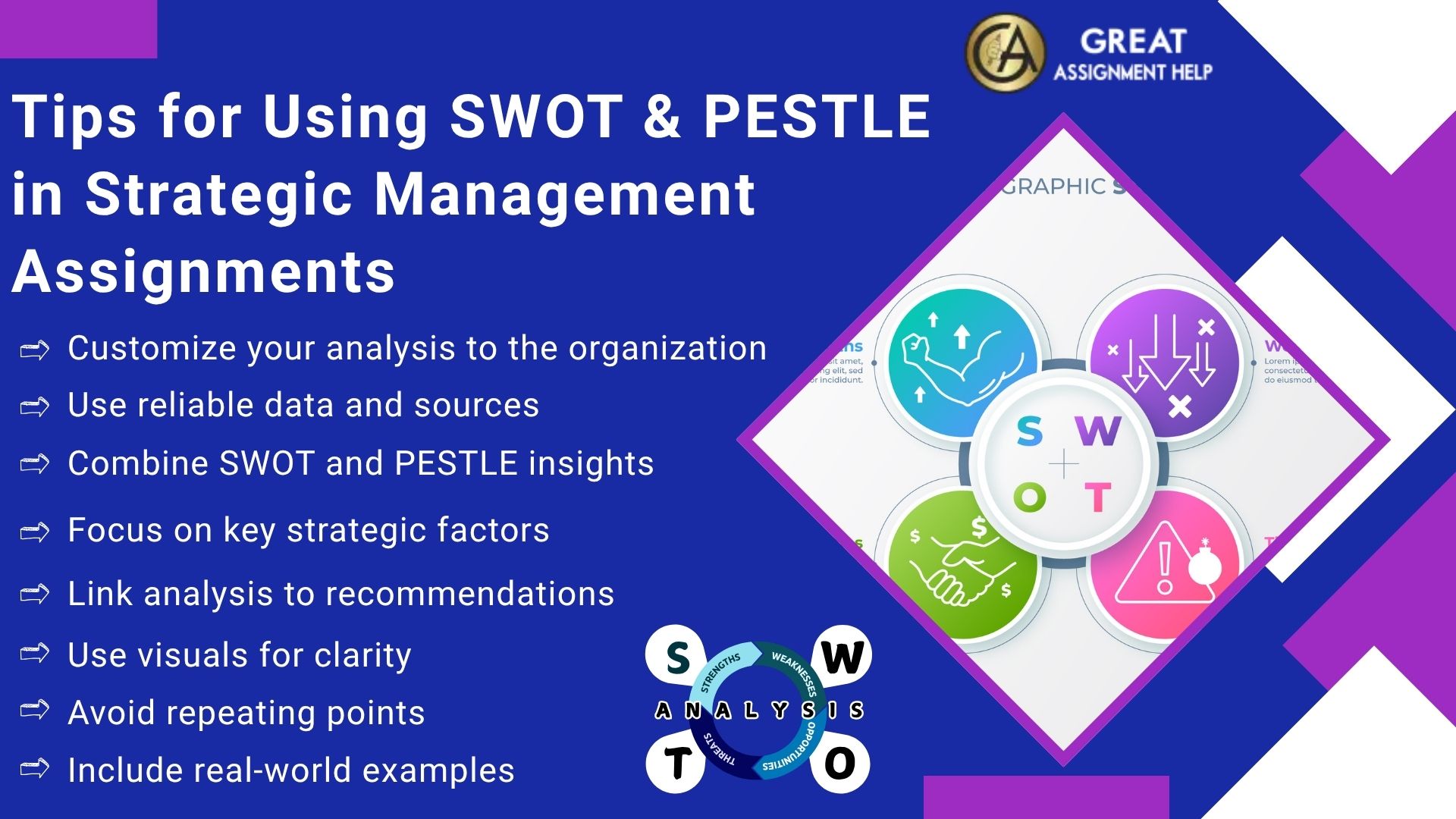Here are some easy tips to use SWOT and PESTLE in strategic management assignments. Focus on important points and use reliable data. Connect what you find in SWOT and PESTLE. Use real examples to explain your ideas. Avoid repeating information and make your work clear with charts or tables.
Strategic management is a key part of business studies. It combines theory with real-life examples to help organizations succeed in the long run. Two popular tools used in strategic management assignments are SWOT and PESTLE analyses. These analytical frameworks help students and professionals understand a company’s strengths, weaknesses, and the external factors that affect it, which is important for making smart decisions. Moreover, knowing how to use SWOT and PESTLE analysis properly in strategic management assignments will not only boost the grades of students but also improve their ability to think strategically. If you are a student who has no idea about these analytical tools, then read this blog. Here, we have shared some key tips for using SWOT and PESTLE in strategic management assignments. By following them, you can achieve the expected outcome.
What is a SWOT Analysis?
SWOT stands for Strengths, Weaknesses, Opportunities, and Threats. It is a simple but useful analytical tool that will help you look at both the inside and outside factors that affect a business.
- Strengths and Weaknesses are internal aspects. These might include things like a strong brand, skilled employees, unique technology, lack of resources, or poor operations.
- Opportunities and Threats come from outside the business. These might cover market trends, new laws, changes in technology, or new competitors.
A clear SWOT analysis will give you a complete picture of where a business stands and what smart steps the company can take next. If you do a SWOT analysis properly, then it will become a solid base for making strong recommendations in your strategic management assignments.
What is PESTLE Analysis?
PESTLE (also called PESTEL) stands for Political, Economic, Social, Technological, Legal, and Environmental factors. It is a tool used to examine the big outside influences that can affect a company or industry.
- Political: It focuses on government rules, tax laws, and trade limits that affect how businesses work.
- Economic: It covers things like inflation, interest rates, the overall economy, and currency values.
- Social: It involves changes in population, lifestyles, and education that can impact customer behavior.
- Technological: It focuses on new inventions, the use of machines, and progress in research that can change how businesses operate.
- Legal: It includes laws about jobs, safety, and regulations that companies must follow.
- Environmental: It covers issues like climate change, eco-friendly practices, and environmental laws that affect businesses.
PESTLE analysis adds more detail to the “Opportunities” and “Threats” sections of a SWOT analysis. Overall, it will help you better understand the external factors affecting a business.
Tips for Using SWOT & PESTLE in Strategic Management Assignments

SWOT and PESTLE analysis is not just about listing points; you need to deeply analyze, focus on what matters, and think strategically. Follow these important tips when you use these analytical frameworks in your strategic management assignments:
Customize your analysis to the organization
Avoid making general statements. No matter whether you are studying a large multinational company or a small local startup, make sure your SWOT and PESTLE analysis fits the specific situation of the business.
For example, instead of just saying “a strong brand is strength,” you could say, “Apple’s well-known brand and loyal customers help it charge higher prices.” On the other hand, when using PESTLE, you can connect economic trends directly to the company, like “Rising inflation might increase costs for Procter & Gamble, which could affect how they set prices.”
Use reliable data and sources
Support your statements with up-to-date information from trustworthy sources. This will make your analysis stronger and show that you have done proper research. For SWOT analysis, you can use financial reports, company documents, or customer feedback to back your points. For PESTLE analysis, you can use news articles, government reports, or industry predictions to support your ideas.
Combine SWOT and PESTLE insights
Never use SWOT and PESTLE separately; instead, let PESTLE add more detail to your SWOT analysis. For example, a technology trend like adopting AI in PESTLE can be seen as an Opportunity in SWOT. Similarly, a legal change such as tougher labor laws might be a Threat for companies that rely heavily on workers.
Focus on key strategic factors
Not all factors you mention are equally important. Focus on the most important ones and explain why they matter. Organize your points clearly with headings or lists, and describe why a certain threat is more serious than others or why a particular strength gives the company an advantage.
Link analysis to recommendations
Your strategic management assignment shouldn’t just include analysis. Use what you find in SWOT and PESTLE to create clear and practical strategies. For example, if SWOT shows the company has a strong research and development team and PESTLE points to new technology changes, you could recommend strategies that focus on innovating products or forming partnerships in new tech areas.
Use visuals for clarity
Use visual tools like tables, charts, and matrices to make your analysis easier to understand and more effective. A SWOT matrix will help you display all four areas in a clear, simple format, while a PESTLE table will allow you to organize the different factors and show how they might affect the business.
Avoid repeating points
When you use both SWOT and PESTLE in your statistics assignment, avoid repeating the same points. A common error is listing the same threats or opportunities in both without offering new ideas. Make sure to separate general external factors found in PESTLE from how those factors specifically impact the business in SWOT.
Include real-world examples
Whenever you can, use real-life examples to support your points. For instance, Tesla’s focus on battery technology is a strength that matches the growing environmental push for sustainable transportation, which is an environmental factor in PESTLE. These examples show that you can connect theory to real business situations.
If you find it challenging to use tools like SWOT and PESTLE, get Strategic Management Assignment Help from experts online. They will offer you templates, examples, and advice that go beyond regular Management Assignment Help. Also, they will provide specific support to help you improve your strategic thinking and analysis.
Conclusion
SWOT and PESTLE are more than just academic tools. They are useful for real business decisions. When you use them carefully in your assignments, they show that you can think clearly and strategically. Especially by adjusting your analysis to fit the business, focusing on key points, and connecting your findings to smart strategies, you can improve the quality of your work. Get Assignment Help from the management experts on our team if you struggle using analytical frameworks such as SWOT and PESTLE. With our professional assistance, you can use SWOT and PESTLE to understand business problems and find effective solutions.
FAQs
1. Can I use both SWOT and PESTLE in the same assignment?
Yes, and it is actually a good idea. PESTLE helps you add more detail to the external part of your SWOT analysis. This makes your assignment clearer and more complete.
2. What is the biggest mistake to avoid when doing a SWOT analysis?
The biggest mistake is making points that are too general. Each point should be clear, directly related to the business, and backed up with facts or good reasons.
3. How often should I update PESTLE factors in my analysis?
PESTLE looks at outside trends. So, it is important to use the latest information. Usually, updating it each time you work on the strategic management assignment will help you keep your analysis accurate and up to date.
4. Can I use online templates for SWOT and PESTLE analysis?
Yes, templates can help you organize your work, but don’t copy them as they are. Make sure to use your own ideas and include information that fits the business you are analyzing.



